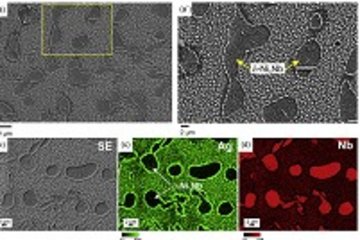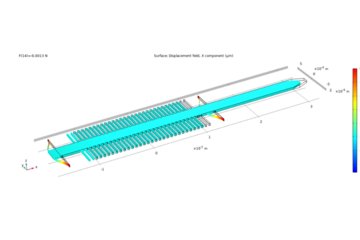All genres
81.
Conference Paper
Hydrogen Plasma Reduction of Iron Oxides. Advances in Pyrometallurgy Symposium, held at the TMS Annual Meeting and Exhibition, TMS 2023, San Diego, CA, USA, March 19, 2023 - March 23, 2023. The Minerals, Metals & Materials Serie, pp. 83 - 84 (2023)
82.
Conference Paper
Hydrogen-Based Direct Reduction of Iron Oxides. Advances in Pyrometallurgy Symposium, held at the TMS Annual Meeting and Exhibition, TMS 2023, San Diego, CA, USA, March 19, 2023 - March 23, 2023. JOM-Journal of the Minerals Metals & Materials Society, pp. 107 - 108 (2023)
83.
Conference Paper
In-Situ Heat Treatment of Fe-TiB2 High Modulus Steel by Additional Laser Exposure During L-PBF. The World PM2022, Lyon, France, October 09, 2022 - October 13, 2022. World PM2022 Proceedings, (2022)
84.
Conference Paper
Comparison between the hydrogen embrittlement behavior of an industrial and a lightweight bearing steel. 23 European Conference on Fracture - ECF23, Funchal, Madeira, Portugal, June 27, 2022 - July 01, 2022. Procedia Structural Integrity 42, pp. 471 - 479 (2022)
85.
Conference Paper
Influence of strengthening mechanisms and environmental conditions on the performance of ferritic steels. In: EUROCORR 2017 - The Annual Congress of the European Federation of Corrosion. Joint European Corrosion Congress 2017, EUROCORR 2017 and 20th International Corrosion Congress and Process Safety Congress 2017, Prague, Czech Republic, September 03, 2017 - September 07, 2017. (2017)
86.
Conference Paper
1 billion tons of nanostructure – segregation engineering enables confined transformation effects at lattice defects in steels. 38th Risø International Symposium on Materials Science,, Risø, Denmark, September 04, 2017 - September 08, 2017. IOP Conference Series: Materials Science and Engineering 219, 012006, pp. 1 - 12 (2017)
87.
Conference Paper
Alloy design and processing routes for novel high modulus steels. In: PTM 2015 - Proceedings of the International Conference on Solid-Solid Phase Transformations in Inorganic Materials 2015, p. 981 (Eds. Chen, L.-Q.; Militzer, M.; Botton, G.; Howe, J.; Sinclair, C. W. et al.). International Conference on Solid-Solid Phase Transformations in Inorganic Materials 2015, PTM 2015, Whistler, BC, Canada, June 28, 2015 - July 03, 2015. PTM 2015, Whistler, British Columbia (2015)
88.
Talk
Sustainable Metals. Virtual Keynote Perspective Lecture, Materials Chain and Materials Science Department, RUB
, Bochum, Germany (accepted)
89.
Talk
Segregation and Transformation at Lattice Defects in Complex Alloys: A Microstructure Design Toolbox. MRS Fall Meeting 2018, Boston, MA, USA (2018)
90.
Talk
Design of cost-efficient high modulus steels as innovative lightweight materials. Advanced Composite Materials Congress, Stockholm, Sweden (2018)
91.
Talk
1 Billion Tons of Nanostructure - Metastability Alloy Design and Segregation Engineering. 38th Risø Intern. Symp. Materials Science Advanced Metallic Materials by Microstructural Design , Roskilde, Denmark (2017)
92.
Talk
ICME study of particle damage behaviour in Fe–TiB2 metal matrix composites. EUROMAT Conference 2017 , Thessaloniki, Greece (2017)
93.
Talk
Metastability Alloy Design. 16th Intern. Conference on Rapidly Quenched and Metastable Materials (RQ16), Leoben, Austria (2017)
94.
Talk
Neuartige HochModul und NDS Stähle durch Sprühkompaktieren und verwandte Verfahren. Fachausschuss 22 AWT, Bremen, Germany (2017)
95.
Talk
Innovative Stähle. Handelsblatt Tagung, Düsseldorf, Germany (2017)
96.
Talk
Rapid Alloy Prototyping – High Throughput Bulk Metallurgy at the MPIE. Workshop on machine learning and data analytics in advanced metals processing, RollsRoyce Institute Manchester, Manchester, UK (2017)
97.
Talk
Innovative structural materials for lightweight design. Seminarvortrag Verfahrenstechnik IWT, Bremen, Germany (2017)
98.
Talk
ICME study of particle damage behaviour in Fe–TiB2 metal matrix composites. DGM Microstructure Mechanics Seminar, Aachen, Germany (2017)
99.
Talk
Segregation Engineering - Solute Decoration, Complexions and Transformations for Self-Organized Metallurgical Bulk Nanostructures. MRS Fall Meeting, Boston, MA, USA (2016)
100.
Talk
Tailoring microstructures from amorphous precursors: crystallization and corrosion in Fe-based amorphous alloys. EMN Meeting on Metallic Glasses 2016, Kuala Lumpur, Malaysia (2016)











